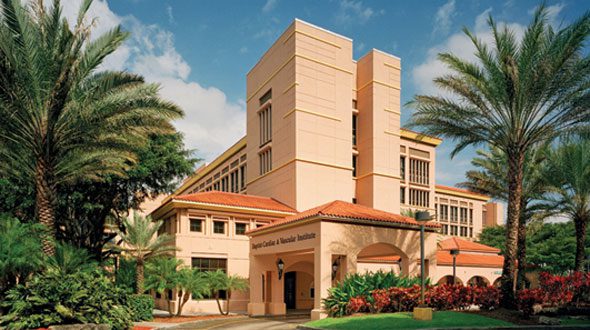 Carlos Gutierrez of Miami made history as the 1,000th patient to receive a treatment pioneered nearly 20 years ago in South Florida by a team of doctors at Baptist Cardiac & Vascular Institute.
Carlos Gutierrez of Miami made history as the 1,000th patient to receive a treatment pioneered nearly 20 years ago in South Florida by a team of doctors at Baptist Cardiac & Vascular Institute.
The innovative repair allows patients to evade a silent killer that tends to strike at midlife and into the golden years.
Doctors recently told Gutierrez, 63, that he was a victim of an abdominal aortic aneurysm. It is called a silent killer because the bulging of the aorta grows without symptoms. Had his aneurysm gone undiscovered, it was large enough to burst, resulting in a painful death.
Gutierrez went home the following day after treatment.
“More than 1,000 patients keep on living because of our commitment not only to practicing medicine but to improving it,” said Barry T. Katzen, MD, founder and medical director of the Institute.
Eighteen years ago Philip Shroyer, 72, was the second patient in South Florida to receive the treatment when he was living in what is now Palmetto Bay. The retired mail carrier had participated in a clinical research trial at the Institute, one of only five centers in the nation and the only center at the time in South Florida treating the disease using an experimental, less invasive technology.
Rather than open the abdomen, doctors entered the groin and traversed a highway of blood vessels to reach the aorta. They repaired the bubbled blood vessel with small, tube-like devices called stent grafts.
Shroyer went home days after the procedure and returned to work a few weeks later at a time when open surgery required months for recovery. Today, Shroyer is a healthy, active retiree enjoying his grandchildren.
The Institute’s unique multidisciplinary approach to cardiovascular treatment was evident during the milestone procedure performed by two interventional radiologists, Dr. Katzen and James Benenati, MD, and vascular surgeon Athanassios I. Tsoukas, MD.
They repaired Gutierrez’s aneurysm using the endovascular procedure pioneered by Dr. Katzen, Dr. Benenati, Orlando Puente, MD, and the late Jose Alvarez, MD.
“It’s an incredible landmark because of the total number of patients we have treated,” said Dr. Benenati, the Institute’s medical director of the Peripheral Vascular Laboratory.
Institute doctors performed their first aneurysm repair on Mar. 17, 1994, at a time when it was so experimental there was still an issue about whether interventional radiology, a fledgling specialty, should be involved in what traditionally had been a surgeon’s domain.
“The easiest thing would have been just to operate with open surgery, but we were willing to push the envelope and try not to operate. We were on the forefront,” said Dr. Puente, a vascular surgeon.
Institute doctors, who continue to perform the most abdominal aortic aneurysm repair procedures in South Florida, are invited to teach their knowledge around the state, nation and the world.
“We are still the go-to people because of our wealth of experience,” Dr. Benenati said. Abdominal aortic aneurysms are the 15th leading cause of death in the United States. One in 250 persons, most frequently males, are expected to develop the disease.
“In the old days a good primary physician could palpitate the abdomen and find the mass if it was big. Now most aneurysms are diagnosed by screening tools such as CT scans or ultrasounds. Many times they are found while a patient is being tested for other issues,” Dr. Tsoukas said.
Formerly, the only treatment for an abdominal aortic aneurysm was for a surgeon to open the abdomen, wrap the swelling aorta with a plastic wrap much like sandwich wrap, and hope it would last awhile to prevent rupture. Such an operation added six years to the life of Albert Einstein.
In the 1950s, surgeons began repairing and replacing the aorta with synthetic tubing called vascular grafts. While very effective in preventing rupture and prolonging life in many patients, the procedure itself is highly invasive, requiring long hospital stays, ICU resources, and is associated with some mortality and complications which could be quite significant.
The modern operation, called an endovascular aortic repair, has become standard procedure that adds decades to the lifespan of otherwise healthy individuals with greatly reduced risk and hospital stay.
Baptist Cardiac & Vascular Institute is part of Baptist Health South Florida, the largest faith-based, not-for-profit healthcare organization in the region. Established in 1987, the Institute treats heart and blood vessels as a single entity within a multidisciplinary framework that brings together specialists from all areas to collaborate on giving patients the best possible care.






